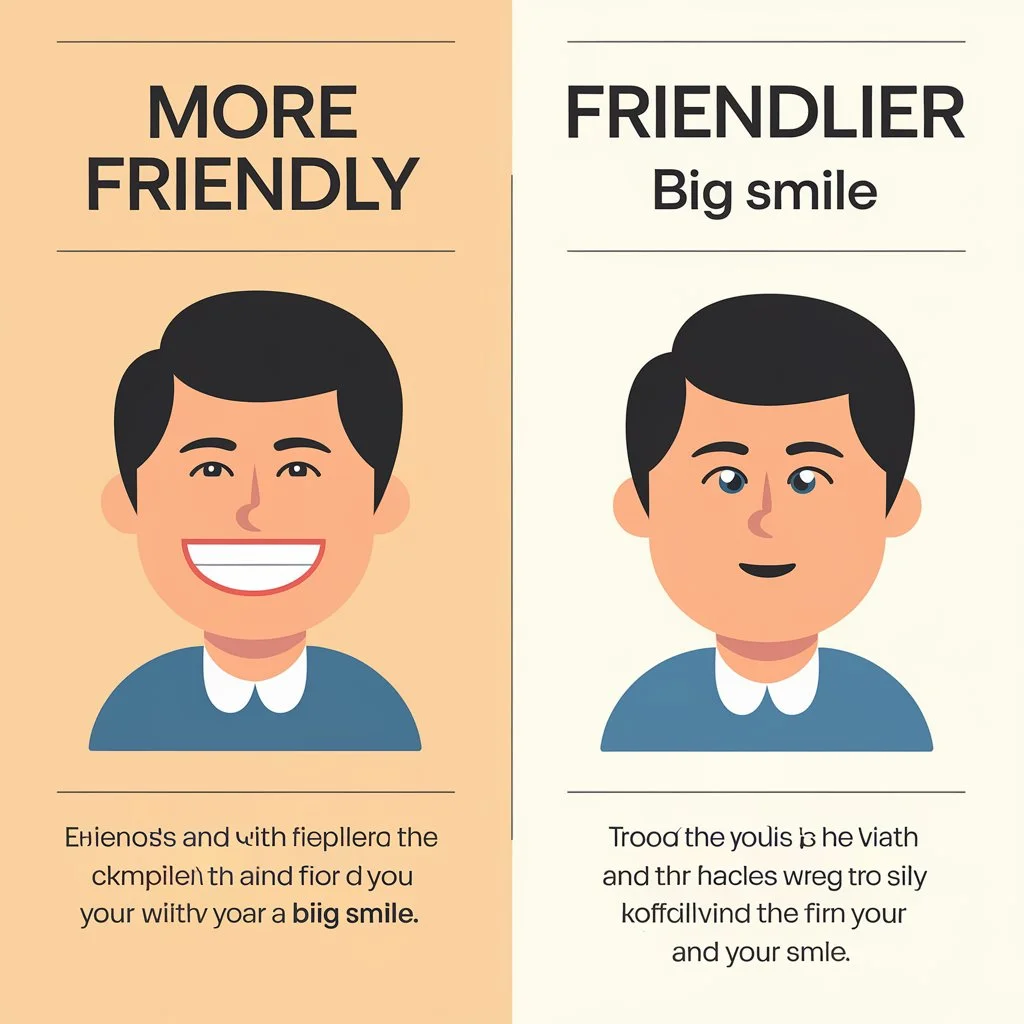Have you ever paused before writing “more friendly” or “friendlier” and wondered which one is correct? You’re not alone! Many writers, even experienced ones, get caught in this little grammar puzzle. The good news is that both options are technically correct, but they’re used in different contexts. Knowing when to use each one can help improve your writing and make you sound more natural.
In this guide, we’ll explore the differences between “more friendly” and “friendlier”, explain how comparative adjectives work in English, and provide tips for choosing the right form based on your tone and context. By the end, you’ll feel more confident when writing and avoid common mistakes. Let’s dive into the basics first.
Understanding Comparative Adjectives in English
What Are Comparative Adjectives?
Comparative adjectives are used when we want to compare two things or people. They help us show how one thing is different from another, usually in terms of size, quality, or other characteristics.
For example:
- “Sarah is taller than Mike.”
- “This movie is more exciting than the last one.”
In these examples, “taller” and “more exciting” are comparative adjectives. They show how Sarah and Mike, or the two movies, are different.
How Do We Form Comparative Adjectives?
There are two main ways to form comparative adjectives in English:
- Add “-er” to the adjective (like “small” becomes smaller).
- Use “more” before the adjective (like “interesting” becomes more interesting).
But which method do we use for “friendly”? Is it “friendlier” or “more friendly”? The answer is that it can be either! This is where it gets a bit tricky, but don’t worry – we’ll break it down.
The General Rule for Comparative Adjectives
Here’s a simple rule to follow:
- For short adjectives (usually one syllable), we add “-er” at the end. For example, “big” becomes bigger, and “fast” becomes faster.
- For longer adjectives (usually three syllables or more), we use “more” before the word. For example, “beautiful” becomes more beautiful, and “expensive” becomes more expensive.
This sounds easy, right? But what about two-syllable adjectives, like “friendly”? This is where things get a little more complicated.
Why “Friendly” Is Tricky
Although “friendly” has two syllables, it can follow either rule:
- Friendlier: This follows the “-er” rule, as if “friendly” were a short adjective.
- More friendly: This follows the “more” rule, like longer adjectives.
Both are correct, but they may sound different depending on the context or tone of your sentence. So, when should you use “friendlier” and when is “more friendly” the better choice? We’ll cover that next.
More Friendly Or Friendlier: What’s the Difference?
When to Use “Friendlier”
Let’s start with “friendlier”. This form feels more casual and is often used in everyday conversation. It sounds more natural when speaking informally or when the situation doesn’t require a lot of formality.
For example:
- “The new neighbor is friendlier than the last one.”
- “The dog is friendlier when it’s sunny outside.”
In these examples, “friendlier” fits perfectly because the tone is casual and friendly. It’s a quick and easy way to make comparisons in informal writing or speech.
When to Use “More Friendly”
On the other hand, “more friendly” tends to sound more formal. It’s often used in professional writing or when the tone is more serious. This form can feel more polished or precise, which is why it’s common in business emails or academic writing.
For example:
- “Our customer service team has become more friendly since the training.”
- “The new software is more friendly for first-time users.”
Here, “more friendly” sounds more suitable because the tone is more professional. It might also be preferred when you’re trying to emphasize a slight difference in friendliness, especially in a business setting.
How to Choose Between the Two
So, how do you know when to use “friendlier” or “more friendly”? It comes down to two key factors:
- Tone: Are you writing something formal or informal? For informal writing, like texting a friend or having a casual conversation, “friendlier” is probably your best bet. For more formal writing, like emails, reports, or professional documents, “more friendly” might feel more appropriate.
- Clarity: In some cases, using “more friendly” can make your sentence clearer, especially if there’s a need to emphasize the improvement or difference. For example, “Our new policy is more friendly to employees” sounds clearer than “Our new policy is friendlier to employees.”
By keeping these two factors in mind, you can decide which form works best for your sentence.
Common Grammar Mistakes with Comparative Adjectives
Even though comparative adjectives are simple to use, there are still some common mistakes people make. Let’s go over a few of them to help you avoid errors in your writing.
Using Both “More” and “-er”
One of the most common mistakes is combining both “more” and “-er” in the same sentence. This usually happens when people are unsure which form to use, so they try to use both. For example:
- Incorrect: “This coffee is more stronger than the last one.”
- Correct: “This coffee is stronger than the last one.”
You should never combine “more” and “-er”. It’s one or the other, depending on the adjective.
Using the Wrong Form for Longer Adjectives
Another common mistake is using “-er” with adjectives that should use “more”. For example:
- Incorrect: “This assignment is harder than the last one.”
- Correct: “This assignment is more difficult than the last one.”
Always remember that longer adjectives, especially those with three or more syllables, use “more” instead of “-er”.
Forgetting About Tone and Formality
Some people forget that the choice between “more friendly” and “friendlier” can change the tone of their sentence. It’s important to think about the context and audience when writing. In professional settings, choosing “more friendly” can make your writing sound more polished, while “friendlier” works better for casual conversations.
By avoiding these common mistakes, you’ll improve your writing and make fewer grammar errors.
The Role of Style and Tone in Word Choice
When you’re deciding between “more friendly” and “friendlier”, the style and tone of your writing play a big role. Let’s explore how these two factors influence your word choice.
Formal vs. Informal Writing
As we’ve discussed, “friendlier” tends to sound more casual, while “more friendly” feels more formal. So, when choosing between the two, think about the style of your writing.
For example:
- In a formal letter or business email, you might write: “We are working to make our website more friendly for all users.”
- In a casual conversation or informal blog post, you could say: “I think the new team is much friendlier than the last one.”
By matching the formality of your writing with the right comparative adjective, you’ll sound more natural and professional.
Using Tone to Set the Right Mood
Your choice between “friendlier” and “more friendly” can also affect the tone of your writing. For example:
- “Friendlier” can make your writing sound warmer and more personal. It’s perfect for a friendly, conversational tone.
- “More friendly” can make your writing sound neutral and professional. It’s ideal for situations where you need to maintain a formal tone without being overly casual.
By paying attention to the tone, you can ensure that your writing feels right for the situation.
Examples of “More Friendly” Or “Friendlier” in Sentences
To help you get a better feel for how to use “more friendly” and “friendlier”, let’s look at some examples.
Examples of “Friendlier”
- “The new teacher is much friendlier than the old one.”
- “The hotel staff was so friendlier during our second visit.”
- “I find dogs to be friendlier than cats.”
In these examples, “friendlier” is used in a casual tone, which works well for everyday conversation.
Examples of “More Friendly”
- “Our office environment has become more friendly since the team-building activities.”
- “The app’s interface is now more friendly for new users.”
- “The company is trying to become more friendly towards the environment.”
In these sentences, “more friendly” fits the formal or professional tone of the writing.
Other Adjectives That Follow Similar Rules As More Friendly” Or “Friendlier
Just like “friendly,” there are other two-syllable adjectives that can be tricky when forming comparisons. Let’s look at a few examples and how they work.
Clever
- “Cleverer”: This form is used in more casual writing or speech.
- “More clever”: This form feels more formal.
Simple
- “Simpler”: This is more common in casual or informal contexts.
- “More simple”: This sounds more formal and is often used in professional or academic writing.
Gentle
- “Gentler”: Often used in casual contexts.
- “More gentle”: Common in formal writing or professional settings.
These adjectives follow the same pattern as “friendly”, where both “-er” and “more” are correct, but the tone of the sentence helps determine which form to use.
FAQs
Is it incorrect to use “more friendlier”?
Yes, using “more friendlier” is incorrect because it combines both comparative forms (“more” and “-er”) unnecessarily. In English, adjectives should use either “more” or “-er”, but not both at the same time. So, it’s either “friendlier” or “more friendly”, but never “more friendlier.”
Can “friendly” be used as an adverb?
No, “friendly” is an adjective and not typically used as an adverb. If you want to express the idea of being friendly as an action, you would use phrases like “in a friendly manner” or “in a friendly way.” For example: “She greeted them in a friendly manner.”
Is “friendly” ever used in a negative sense?
While “friendly” itself has a positive connotation, it can be used sarcastically or in specific phrases to imply something negative. For example, “friendly fire” refers to accidental attacks from one’s own side in a military context. But when referring to people, “friendly” is usually positive unless sarcasm is used.
Are there any fixed expressions where “friendlier” or “more friendly” shouldn’t be used?
Yes, certain fixed phrases like “user-friendly” or “eco-friendly” do not change to “user-friendlier” or “more user-friendly” in the same way as regular comparative adjectives. Instead, we would say “more user-friendly” or “most user-friendly” without adding “-er”.
Can “friendly” refer to a relationship between non-living things?
Yes, “friendly” can be used to describe relationships or interactions between non-living things, especially in technology or business contexts. For example, “The software is friendly to new users,” or “The company has a friendly agreement with its competitors.” This usage focuses on ease, cooperation, or compatibility rather than literal warmth or kindness.
Conclusion
Choosing between “more friendly” and “friendlier” might seem like a small detail, but it can have a big impact on the tone and clarity of your writing. Remember, both forms are correct, but they’re used in different ways depending on the formality and tone of your sentence.
Here’s a quick recap:
- Use “friendlier” in informal contexts and casual conversations.
- Use “more friendly” in formal writing, especially in professional or business settings.
- Avoid common mistakes like using “more” and “-er” together.
By keeping these simple tips in mind, you’ll always know when to use “more friendly” or “friendlier” in your writing!

I’m Clara Whitmore, the girl running the show at “Grammer Grove.” I’ve been playing with expressions and formats to make grammer a whole lot of fun. Over at Grammer grove, we’re here to make your English grammer incredible. Let’s add some professionalism and gratitude to yourwritting together!












